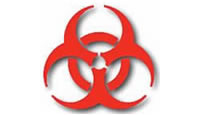- Home
- Public Employees Occupational Safety and Health
- PEOSH Health Standards
- PEOSH Bloodborne Pathogens Standard (29 CFR 1910.1030)
PEOSH Bloodborne Pathogens Standard (29 CFR 1910.1030)
- Overview
- Regulation
- Resources to Help with Compliance
- Frequently Asked Questions
- Additional Resources
Overview
Acquired Immune Deficiency Syndrome (AIDS), hepatitis B (HBV), and hepatitis C (HCV) are serious concerns for workers occupationally exposed to blood and certain other body fluids that contain bloodborne pathogens. Workers in health care and public safety occupations could be potentially exposed.
Regulation
PEOSH has adopted the Bloodborne Pathogens Standard, 29 CFR 1910.1030. Refer to the standard for a complete set of requirements.
Related Links
Resources to Help with Compliance
- US Public Health Service Guidelines for Postexposure Treatment

- Updated U.S. Public Health Service Guidelines for the Management of Occupational Exposures to HIV and Recommendations for Postexposure Prophylaxis, MMWR, September 30, 2005/50 (RR-09)
- Updated U.S. Public Health Service Guidelines for the Management of Occupational Exposures to HBV, HCV, and HIV and Recommendations for Postexposure Prophylaxis, MMWR, June 29, 2001/50 (RR-11)
- Immunization of Health-Care Workers: Recommendations of the Advisory Committee on Immunization Practices (ACIP) and the Hospital Infection Control Practices Advisory Committee (HICPAC)
- CDC Hotline for Questions About Treatment of BBP Exposures
1-888-HIV-4911 or 1-888-448-4911
- Resources for Identifying and Evaluating Safety Devices and Engineering Controls

- List of Available Safety Devices (International Healthcare Worker Safety Center)
- Forms to Evaluate Safety Devices (Training for the Development of Innovative Control Technologies Project)
- Selecting, Evaluating, and Using Sharps Disposal Containers
(National Institute for Occupational Safety and Health) - NIOSH Workbook for Designing, Implementing and Evaluating a Sharps Injury Prevention Program
- Use of Blunt-tipped Suture Needles to Decrease Percutaneous Injuries to Surgical Personnel: Safety and Health Information Bulletin
Frequently Asked Questions
Top ^
Additional Resources
- Bloodborne Infectious Disease Topic Page (National Institute for Occupational Safety and Health)
- Bloodborne Pathogens (OSHA)
- Contact Information for Questions or Concerns Regarding Regulated Medical Waste in the State of New Jersey


